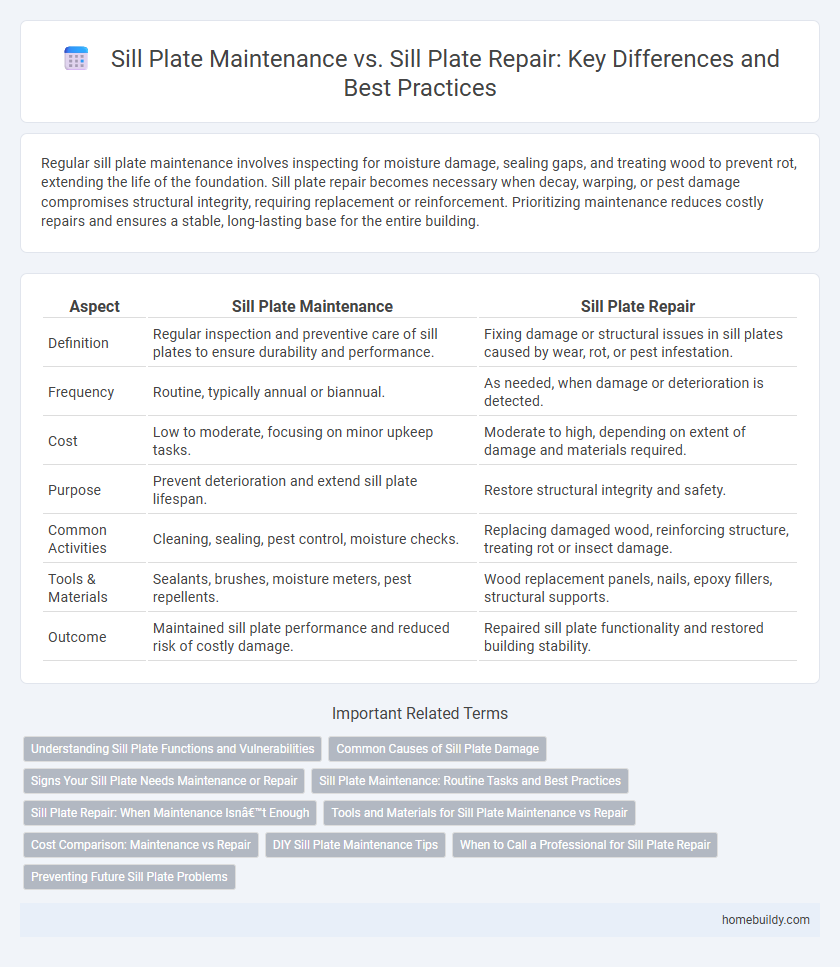Regular sill plate maintenance involves inspecting for moisture damage, sealing gaps, and treating wood to prevent rot, extending the life of the foundation. Sill plate repair becomes necessary when decay, warping, or pest damage compromises structural integrity, requiring replacement or reinforcement. Prioritizing maintenance reduces costly repairs and ensures a stable, long-lasting base for the entire building.
Table of Comparison
| Aspect | Sill Plate Maintenance | Sill Plate Repair |
|---|---|---|
| Definition | Regular inspection and preventive care of sill plates to ensure durability and performance. | Fixing damage or structural issues in sill plates caused by wear, rot, or pest infestation. |
| Frequency | Routine, typically annual or biannual. | As needed, when damage or deterioration is detected. |
| Cost | Low to moderate, focusing on minor upkeep tasks. | Moderate to high, depending on extent of damage and materials required. |
| Purpose | Prevent deterioration and extend sill plate lifespan. | Restore structural integrity and safety. |
| Common Activities | Cleaning, sealing, pest control, moisture checks. | Replacing damaged wood, reinforcing structure, treating rot or insect damage. |
| Tools & Materials | Sealants, brushes, moisture meters, pest repellents. | Wood replacement panels, nails, epoxy fillers, structural supports. |
| Outcome | Maintained sill plate performance and reduced risk of costly damage. | Repaired sill plate functionality and restored building stability. |
Understanding Sill Plate Functions and Vulnerabilities
Sill plate maintenance involves routine inspections and preventive measures to protect the wood from moisture, pests, and structural stress, ensuring the longevity of the foundation's base. Sill plate repair addresses specific damages such as rot, warping, or termite infestation that compromise the connection between the foundation and framing. Understanding these functions and vulnerabilities is crucial for preserving structural integrity and preventing costly foundation issues.
Common Causes of Sill Plate Damage
Sill plate damage commonly arises from moisture intrusion, pest infestations, and wood rot, all of which compromise the structural integrity of a home's foundation. Proper sill plate maintenance includes sealing gaps, treating wood against termites, and ensuring effective drainage to prevent water accumulation. Ignoring these preventive measures often leads to costly repairs, such as replacing rotted timber or reinforcing weakened support beams.
Signs Your Sill Plate Needs Maintenance or Repair
Visible water stains, warped wood, or mold growth on a sill plate indicate the need for immediate maintenance to prevent structural damage. Cracks, soft spots, or uneven settling around the foundation are clear signs that sill plate repair is necessary to restore stability. Regular inspections can detect early deterioration, ensuring timely intervention before costly repairs become essential.
Sill Plate Maintenance: Routine Tasks and Best Practices
Sill plate maintenance involves regular inspection, sealing, and treating wood to prevent rot, mold, and pest infestations, thereby extending the structural integrity of the foundation. Best practices include checking for moisture buildup, applying protective coatings, and ensuring proper ventilation around the sill plate. Routine tasks such as cleaning debris and promptly addressing minor damage reduce the need for costly sill plate repairs and maintain overall building stability.
Sill Plate Repair: When Maintenance Isn’t Enough
Sill plate repair becomes essential when maintenance fails to address structural damage caused by rot, pest infestation, or water intrusion. Unlike routine upkeep that prevents minor issues, repair involves replacing compromised wood to restore foundational integrity and prevent costly further damage. Professional assessment and prompt repair ensure the building's stability and extend the sill plate's lifespan beyond basic maintenance capabilities.
Tools and Materials for Sill Plate Maintenance vs Repair
Sill plate maintenance typically requires basic tools such as a hammer, pry bar, caulking gun, and sealant designed for moisture resistance, alongside materials like wood preservatives and waterproof paint to prevent rot and insect damage. In contrast, sill plate repair involves more specialized tools including a reciprocating saw, power drill, wood epoxies, replacement lumber, and heavy-duty fasteners to remove and replace damaged sections effectively. Proper selection of tools and materials based on the task ensures structural integrity and prolongs the lifespan of the sill plate.
Cost Comparison: Maintenance vs Repair
Routine sill plate maintenance typically involves sealing and inspecting for damage, costing significantly less than major repairs that address rot or structural compromise; maintenance expenses often range from $100 to $300, while repairs can exceed $1,000 depending on severity and materials. Investing in regular maintenance minimizes long-term costs by preventing extensive damage requiring expensive replacement or extensive carpentry work. Homeowners prioritizing sill plate upkeep benefit from reduced financial strain compared to the unpredictable costs associated with repair emergencies.
DIY Sill Plate Maintenance Tips
Regular DIY sill plate maintenance, such as sealing cracks, inspecting for moisture damage, and applying protective coatings, prevents costly repairs and extends the lifespan of the foundation. Proper maintenance minimizes wood rot and insect infestations, reducing the need for extensive sill plate repair. Routine checks and timely caulking ensure structural integrity and energy efficiency in your home.
When to Call a Professional for Sill Plate Repair
Sill plate maintenance involves regular inspections, sealing, and treating the wood to prevent rot and insect damage, whereas sill plate repair is necessary when structural damage, warping, or extensive rot compromises stability. Homeowners should call a professional for sill plate repair if they notice sagging floors, gaps between the foundation and framing, or visible wood deterioration that affects the home's structural integrity. Early professional intervention ensures proper diagnosis, use of appropriate materials, and compliance with building codes to safeguard the foundation.
Preventing Future Sill Plate Problems
Regular sill plate maintenance, including sealing and moisture inspection, prevents wood rot and structural damage. Timely repair addresses existing issues but cannot replace consistent upkeep to avoid further deterioration. Investing in routine maintenance significantly reduces costly repairs and extends the sill plate's lifespan.
Sill plate maintenance vs Sill plate repair Infographic

 homebuildy.com
homebuildy.com